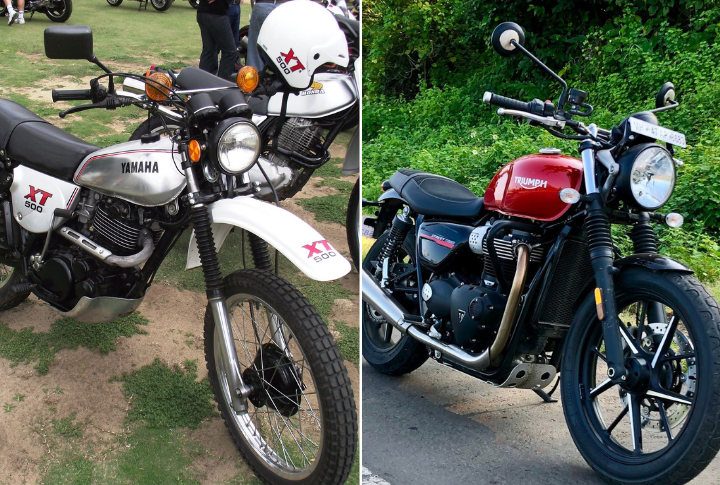
Yamaha’s XT500 and TT500 Thumpers Picked up Where Triumph and BSA Left Off

Triumph and BSA were once the most successful motorcycle brands but ultimately failed when they underestimated their competition. Yamaha seized the opportunity, quickly dominating America and Europe’s adventure and off-road segments. XT500 and TT500 Thumpers picked up where the British legends left off and became iconic models in their own right.
Triumph and BSA Once Dominant Off-road Bikes

BSA motorcycles were popular for competition and street riding because of their quality construction, reliability, and innovative design. Earlier models were also affordable enough for the average rider. Also, Triumph had the Bonneville, a 650cc parallel-twin motorcycle that could achieve 115 mph. Both British brands shaped the motorcycle landscape.
Innovate or Perish

BSA and Triumph were once the world’s largest motorcycle producers. But they underestimated the electric-start Japanese motorcycles competing against their kick-start models. Poor management and slow innovation led to a dramatic decline in the 1950s and 60s. Unfortunately, BSA and Norton Villiers Triumph packed up in 1973 and 1978, respectively.
Yamaha Steps in

When two-stroke machines from Europe and Japan reached America in the 1970s, they took over the market. However, not everyone was swayed by their noise, so Yamaha stepped in with a solution. They released the XT500 and TT500 thumpers, two four-stroke motorcycles that looked like the Britiskes reborn but had the reliability of Japanese models.
Yamaha Built What the Market Wanted

By the mid-1970s, Yamaha saw the writing on the wall for two-stroke engines. They recognized their declining future, especially with tightening U.S. emissions standards. In response, they introduced two performance-oriented four-stroke models in 1976. They aimed to create powerful machines like the renowned British BSA singles that would rival the Honda XL350 and dominate the off-road scene.
Yamaha Releases the XT500 and TT500

Since Yamaha opted for 400cc engines for the Japanese market, they launched the XT500 in late 1975 as a street-legal adventure bike with a 500cc engine. Months later, the stripped-down TT500 arrived for off-road enthusiasts without the XT’s road gear.
Same Bike, Slight Differences

Yamaha produced the same bike but tweaked a few components to sell them as different models. The XT500 was ideal for riders who wanted the road experience, and the TT500 was for motocross racing. The latter had a 430cc engine tuned to produce more power output for a high-revving performance.
Differentiating Features

The XT500 was comfortable for two because of the buddy pegs, which were absent in the TT. Unlike the seats in the dirt-only TT, the XT also had a low seat height of 35.5 inches for average-height drivers and street-friendly Bridgestone trials-type tires. The XT also had modern dual-sport tires, blinkers, and Kayaba gas/oil shocks to make rides smoother.
The Enduro-Adventure Yamaha XT500

Released in 1975, Yamaha’s XT500 sourced most parts, including the transmission and chassis, from Japan. It had turn signals, a neutral indicator, a speedometer, and other features, making it heavier and less agile. Designed as an adventure bike, the XT500 could handle city streets, country lanes, or rough trails. Its dual-purpose handling characteristics made it versatile for various terrains.
This Street-Legal XT Was a Racing Champion

Bengt Åberg raced a modified XT500 in the 1977 Motocross World Championship and Luxembourg Grand Prix, scoring a surprising victory and a top-ten finish. The Yamaha XT500 also dominated early African rallies in the late 70s, such as the Paris–Abidjan-Nice and the Paris–Dakar Rally. These achievements solidified the XT500’s reputation as a versatile and capable machine.
The Bike Paved the Way for Other Models

The XT500 with the four-stroke was the first in Yamaha’s successful XT line. Yamaha has consistently produced versatile adventure bikes, from the small 125cc XT125 to the current 660cc XT660Z Ténéré. These bikes performed exceptionally well, particularly in France, due to Yamaha’s consistent development and refinement over many years.
This Dirt Bike Was Doomed… to Succeed

On its debut at Yamaha’s September 1975 dealer convention, the TT500 was an immediate success in showrooms and competitions like the Paris-Abidjan-Nice race. It was reliable, with a broad power band and ample torque, ideal for long-distance. The TT was easy to start, built for durability, and required minimal maintenance.
Importance of a Durable Engine

The TT was the ideal bike with an air-cooled, single-cylinder engine displacing 499cc. Powered by a 34mm Mikuni carburetor with push-pull cables, it delivers strong, responsive power. The overhead cam, driven by a chain from a right-side sprocket, uses the same pitch as the Yamaha 650 Twin. This engine is a workhorse, and its features ensure its durability.
Other Features Complemented it’s Engine

The TT500’s quiet exhaust can be deceptive, making it easy to overestimate speed without realizing it. Its high rear air intake uses a washable foam element for filtration. Also, the mild steel frame has a skid plate that protects the underside and engine from road debris or rugged terrain.
The TT Was a Success By All Means

Yamaha released the TT500 in the right season, which was a hit with riders. It sold well, and companies like White Brothers, Powroll, and Pro-Tec offered numerous performance upgrades. White Brothers provided parts like 36mm Mikuni carbs, high-compression pistons, big-bore kits, and Hallman-Lundin frame kits, elevating the TT500 as a top-tier dirt bike.
Yamaha’s XT and TT 500 Models are Still Standing Strong

These bikes still deliver a lovely four-stroke sound with enough power in a durable, low-maintenance package. So, it’s not surprising that there’s a market for riders using TTs in flat-track racing. Since the 500s still have a dedicated following, including active online forums supporting these iconic bikes, original models can fetch over $3,000.


